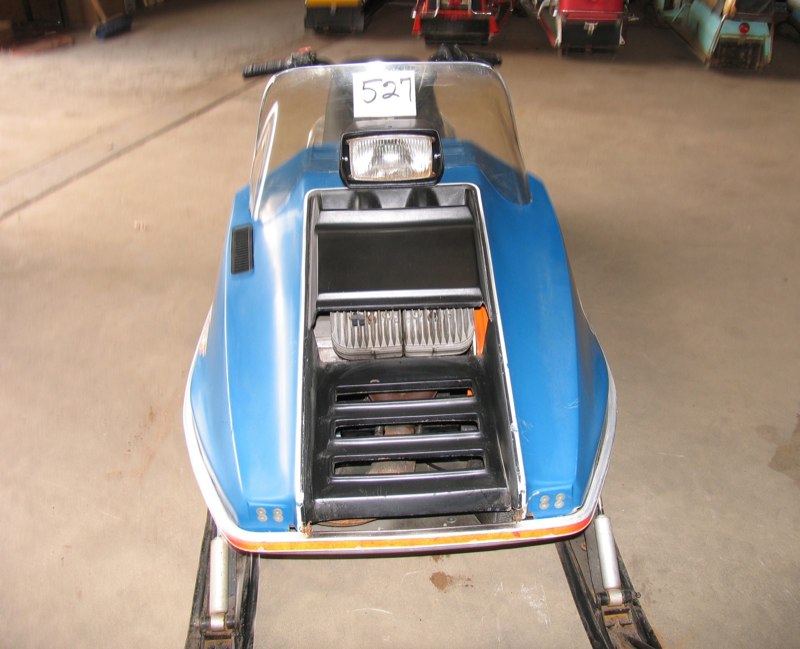
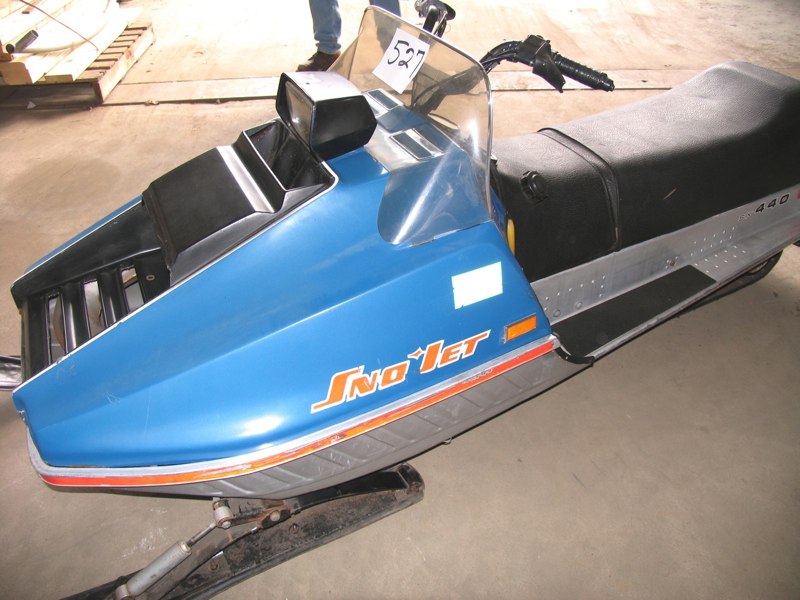
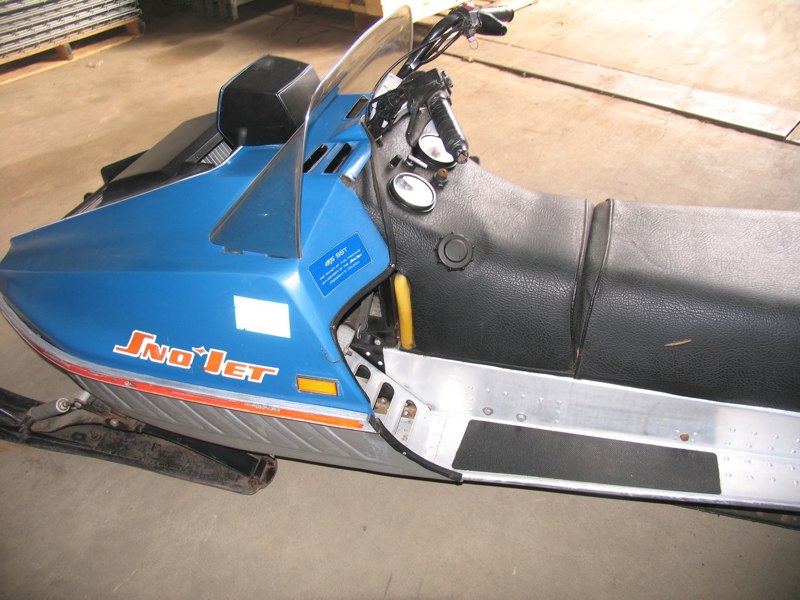
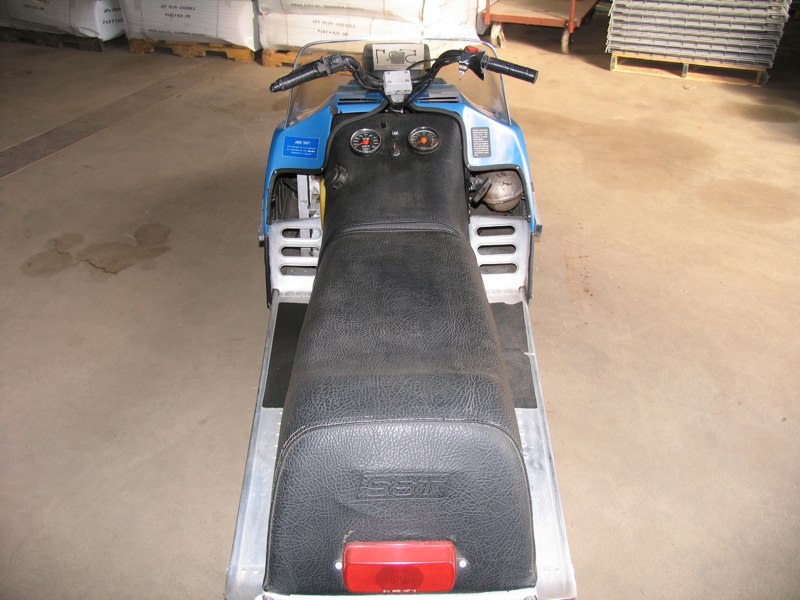
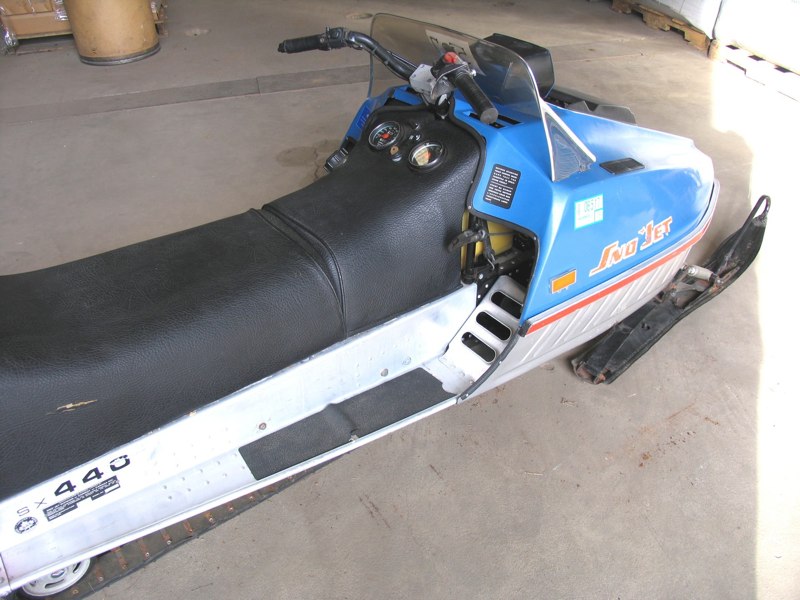
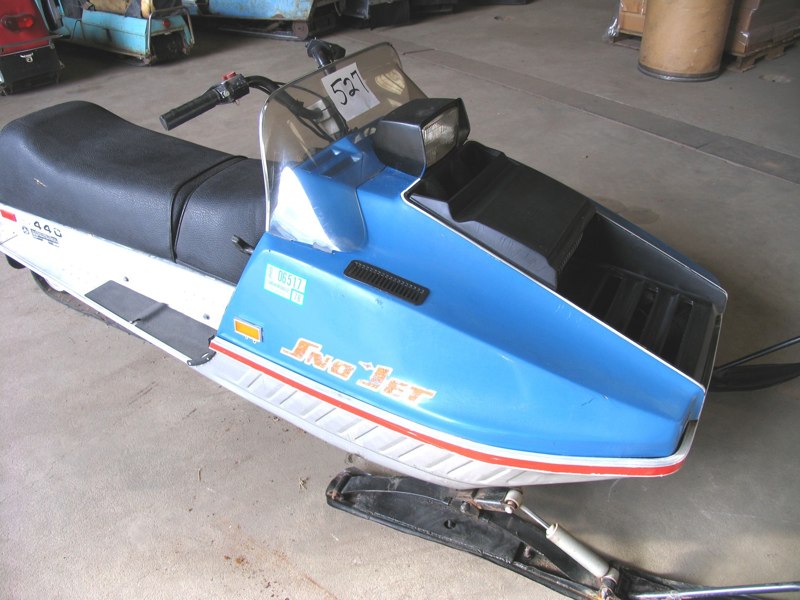
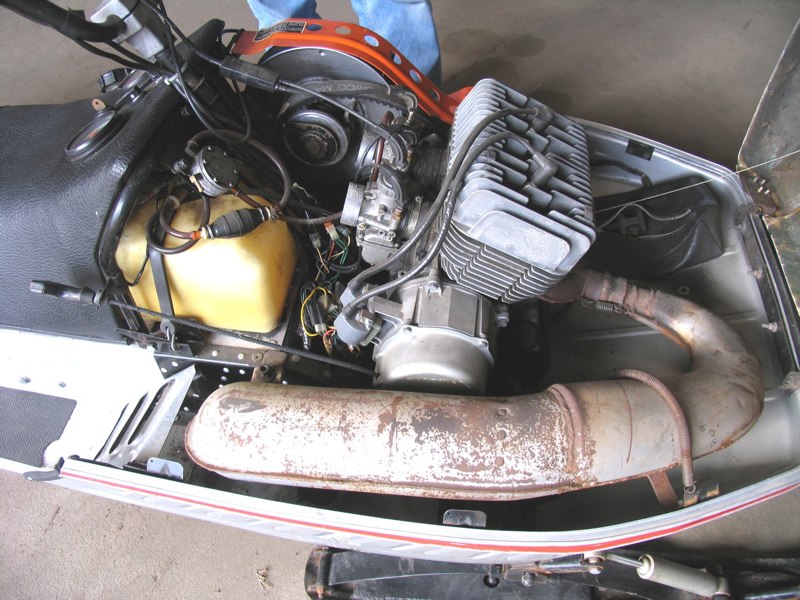
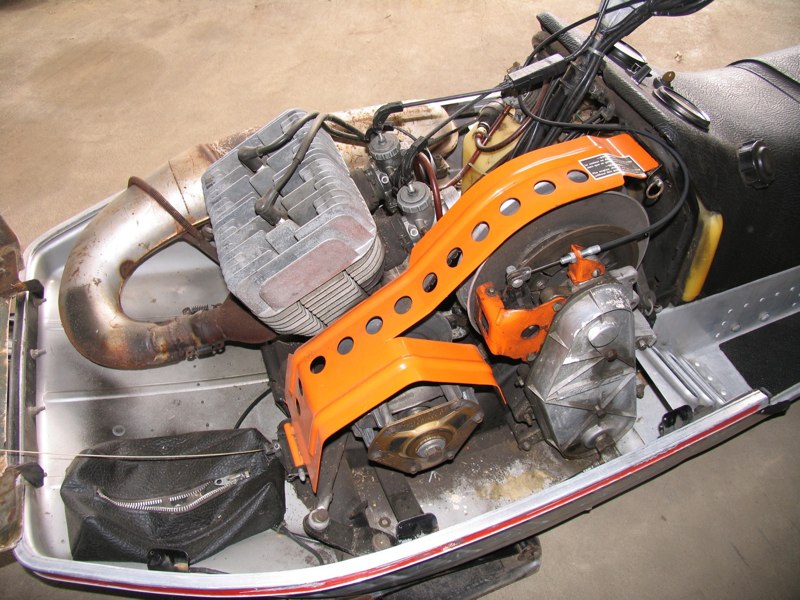
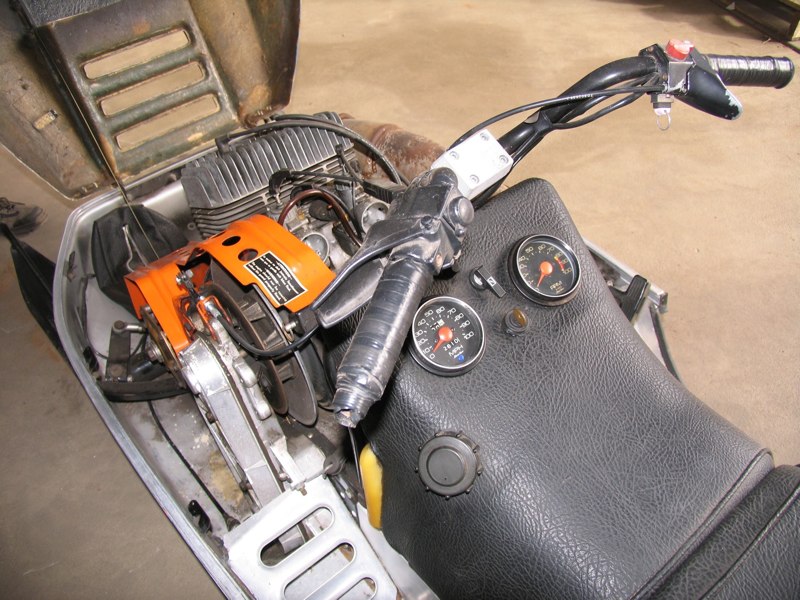
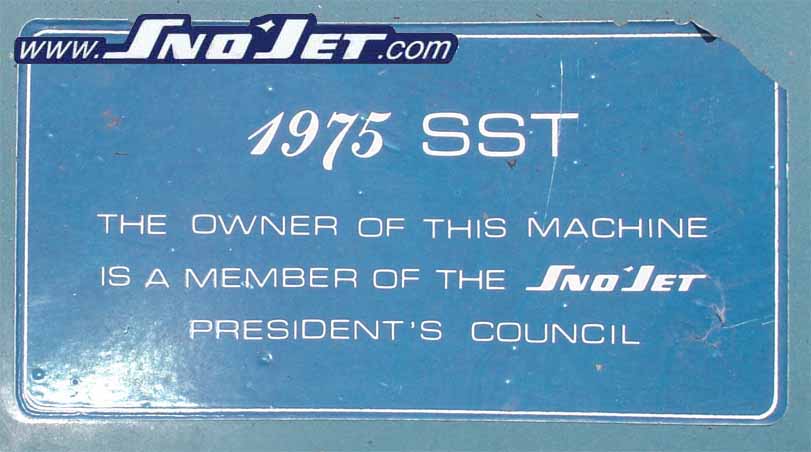
This article came about as a result of doing research on a vintage Sno Jet prototype that I acquired. In doing this research I have communicate with several former Sno Jet personal and associates, they all were very helpful. I am sincerely thankful and appreciative of the time and information everyone contributed. Most did not want their name on the web or in print media, two individuals willing to have their names mentioned were Peter Morris and Gordon VanAmburg. Nearly all of the communication was verbal with the exception of Peter Morris. Almost without exception, each individual stated that, it has been 30-40 years and the information is to the best of their memories. The best way for me to organize it was to combine the information into a series of articles. The research migrated into several Sno Jet related topics, making it impossible to include it all in one. Virtually all of my communication with Peter Morris was written, which made it nice to refer to over the notes I made from others and handy to select some applicable quotes. Thanks Pete for your additional time spent typing and your willingness to be quoted. The information gained from all is intertwined into the content throughout. I have written additional articles on the topics of; Sno Jets Last Prototype, Prototypes and the Phantom Jet and Targeted History Timeline Sno Jet. Some overlap may exist to allow the articles to stand-alone.
*Notates a quote
What was this “Presidents Council” and these sleds called the “presidential’s’” what are the details of their existence and purpose? The prototype I was restoring had hood side “Sno Jet” decals that were identical to these so called, within the vintage collector community, presidential sleds. In looking and asking around for answers, it became evident at least in the directions I had gone that there were few and sketchy details. Fortunately some of the contacts I had made provided what I was looking for, one of them was Gordon VanAmburg. Gordon was the owner of one of Sno Jets largest volume dealers and had the honor of sitting on the Presidents Council. In addition he was the main character in a promotional film Sno Jet produced in the 1974 model timeframe.
* “Glastron decided to invest in developing a line of sleds that would give the big boys a run for their money. In searching for top-quality engineers and stylists... no one seemed too delighted with the fact they'd have to move to the asbestos capital of the universe, in a location that spoke French… remote from any life forms. This prompted Glastron to set up an R&D facility in a place where talent would love to migrate. But, not so distant from the factory that all liaison would be impossible. Essex, Vt was chosen. So, Duane, Bob, and Harlan (and then me) were brought in to start on a machine that would open eyes, and put Sno-Jet on the map. Stage I of that assault was to create a racer that would blow the rest out of the water.” Peter Morris
The assault weapon was of course the Thunder Jet. Its success and place in history is truly legendary but its purpose here is merely to help set the stage. The success realized by the T-Jet and a number of happenings in the snowmobile industry were cause for Conroy and Sno Jet to do some strategic planning. At a time when things weren’t really going that well in the industry and manufacturers were dropping out, Sno Jet implemented an aggressive growth plan consisting of a; three phase 3.5 million expansion of its manufacturing and parts capabilities and plans for a two phase new model release. The first phase of the new model release was the all-new SST, the second phase promised to be revolutionary and was planned for the 1976 model year. Sno Jets plans were BIG, they had their sites set on the likes of Bombardier, Polaris and Cat. They believed that in order for them to be sustainable long term, they had to become one of the manufacturers at the top of the heap and they honestly felt they could do it.
* “If we were going to catch up, and pass, Ski-Doo we'd need even more engineers and stylists. As related earlier, the gas crisis, and a couple of seasons with sparse snow on the ground... forced Glastron to ponder what might become of Sno-Jet, and indeed the entire snowmobile industry. They reasoned that if these were temporary issues... they should be in a position to take a commanding lead in the industry, by offering the most desirable sleds when the market recovered. On the other hand, if these conditions were seen as writing on the wall for a doomed and collapsing industry... they should also be in a strong position in considering an exit strategy. If Sno-Jet became a major player, and had some very advanced machines in the on-deck circle for future model offerings... they would have a company of value to sell. They decided not to just pull the plug, and let the company die of it's own weight, like many companies.” Peter Morris
The emphasis here and in my article on the Phantom, centers on this two-phase model release. Sno Jet fully intended this, one… two… punch in 1975 and 1976 to catapult them to a lead position in the industry.
The Council
As part of these expansion plans Sno Jet formed what would be called the “Presidents Council”. The council was made up of roughly 20 individuals consisting of select; Sno Jet, distributor and dealer members and was headed by Conroy’s President Keith Orme.
The council met on occasion to interact and discuss a number of typical items which could include; company plans, new models, marketing, advice/feedback from dealer level, services, parts and the like. They would tour the facility to view new additions, advancements and work in progress. Pre-production examples of the next model years sleds would be presented to them for evaluation. They normally would have the opportunity to ride many of them, give feedback on them and be part of the final decision process prior to final changes, media presentation and production. The last specific meeting for new model review was for the 1975 models, which was a BIG year of changes. There were plans to do the same for the 1976 model presentation, but that gathering never took place due to the state of the company when the time came.
The promotional film I spoke of earlier actually has a segment devoted to one of these council meetings that took place around the time of the 1974 models. I have a copy, which I don't recall where or when I got. The film is way cool for the time and certainly can bring some chuckles viewing it nearly 40 years later. I was able to convert it to a digital form and have posted it on youtube if you wish to watch it. Here is the link, its about 15 minutes in length.
SST totally revamped breakthrough machine, which ones are “Presidential”
The expansion plan was well under way, the first phase model release, the all new SST, was nearing its completion. They had spent nearly two years and over 600,000 just in design and tooling to get to this point. It was a BIG year of changes for them and they wanted to make as much noise as they could. Sno Jet and the council decided to release and launch the new SST model in a way never done before by Sno Jet or any other manufacturer for that matter. Not only were they going to have 1975 SST’s in dealer showrooms for them to sell by February 1974, but they were going to give some away too. Think about it, that’s putting next years sled on the snow this winter, not just a handful for a couple lucky souls, but around 200 of them, so you or your neighbor could easily have purchased one. This is something that was really unheard of especially for the time. It gets better though, like I said they also gave some away.
* “…with the first new 1975 machines already in dealers hands this past winter.” “A limited number of these new sleds were released to its distributor and dealer organization for thorough testing and evaluation. Each owner was enrolled in the Sno Jet President’s Council, and completed an extensive appraisal to be used in future development and modification.” Snow Goer Trade 5/74
Sno Jet selected the 440 F/A SST, the flagship of the all-new SST to be the early release version of the model. In January 1974 they fired up the production line and built about 200 of this model for consumer purchase availability. They also built around two-dozen specially prepped units to give away under the “Presidents Council” early release feedback program, something they had never done before. The three factors that set these sleds apart were the hood color, a special decal and a special feedback packet. The two-dozen’ish specially prepped sleds had a hood color that was not only a darker blue but also had a metallic effect in the color finish, they were affixed with a special decal that stated “1975 SST The Owner Of This Machine Is A Member Of The Sno Jet President’s Council” and they came with special documents that required written feedback be provided back to Sno Jet.
All these machines, both the early production and the president’s council sleds, were production not prototype units, they were however coded as “early production” in their model number. These along with about 100 “interim production” unites which were built in July 1974, had a number of parts that would ultimately be changed prior to the fall 74 production of the same model. Some of the unique parts were; hood opening and decals, front bumper and accent strip, fuel tank and cover, clutch guard paint color and XA cylinders to name several. There seems to be very little recollection as to why the parts changes came about other than the decal changes which were due to strong negative feedback from the dealer network. In general the message was, they were two plain and the red accents didn’t go over that well either. One dealer who sold a couple and went to the regional meeting to discuss them remembers a lot of service issues with them and held off buying his personal 440 F/A until they built the September units. The interesting fact is these top-performing sleds flew off the showroom floors into consumer hands. The launch was so successful, that more were built mid summer to keep them in front of the consumer and admittedly to use up some parts prior to the parts changeover. Based on this the consumers must not have minded the looks of these sleds, too much anyway.
Because relatively few, probably around 300 total, of these uniquely parted sleds were built and until recently their details had faded into a dusty history, they have all been referred to as “a presidential SST”. It’s a label that will probably stick for some time even though the true “Presidential SST’s” numbered somewhere around two-dozen with very few known to exist today. Regardless of which model; the presidential early, the normal early, or the interim production, they all are highly sought after collector sleds today which any Sno Jet fan would be proud to have. These sleds were considered Sno Jets ticket to the major snowmobile manufacture league.
Following are some pictures of a “presidents Council” SST, which is currently owned by Ed Webb and provided with his permission. A normal “early or interim production” sled would look just like this sled except its hood color would be the typical lighter blue and it would not have the special “president’s council” sticker.










Following is a normal (not early or interim) production SST 440 F/A, built September 1974 which I currently own. This would be an example, after the parts changes took place and what the normal color looked like.
* “…some of the main players in the development of the SST: Randy Eilert, stylist/ Phil Craven?/ main engineer/ Harlan Lipker, proto mechanic, Jean-Pierre Monfette and Gene Whitney, clay modelers. There would have been others who were involved in a less hands-on way... like VPs, marketing, service and parts, etc… …Mr. Monfette may have a bunch of pix of the clay model as it took form. I believe I did the drafting for the decals and appliqués, and actually cut them from film with a #11 Exacto knife.” Peter Morris
* “Sno Jet has invested 1.2 million dollars in engineering and tooling for a completely new line of snow machines for 1975 to be complimented by a revolutionary new machine already built and in testing for 1976!” Keith Orme Snow Sports dealer news 5/74
* “Sno Jet Announces Early Release- Keith M. Orme, President of Sno Jet has announced the release of a limited quantity of the firms 1975 SST models to dealers. This action has been taken as part of Sno Jets year-around manufacturing program, and is believed to be a first in the snowmobile industry. Each machine is fitted with a special decal on the cowling which identifies the owner as a member of the Sno Jet President’s Council. In making the announcement, Orme noted that the 1975 SST has been in development and testing at the factory level for over 18 months. “We feel that this program will give our dealers an opportunity to participate more fully in designing and developing the snowmobile of the future.” Orme added, “Since these SST’s represent the most modern technology available in the industry today, our dealers won’t be evaluating an outmoded design, but instead will be able to see clearly our commitment to the future of snowmobiling.” Each machine is accompanied by a comprehensive appraised booklet which allows the rider to make a compete report on his personal observations and recommendations. Orme and other senior management personal from Sno Jet will be holding a series of regional dealer meetings throughout Canada and the United States shortly to discuss the machine evaluations, as well as other issues of concern and interest to dealers.” Michigan Snowmobile Winter 73/74
* “Sno-Jet had selected baby blanket blue to distinguish itself from those already ‘trademarked’ colors… …I doubt that anyone in the company would have chosen a light blue, if we had first dibs. Especially with the macho advertising campaign later on… …So, I think the darker shades of blue were introduced as a way of making a gradual move away from the light blue. In offering it on limited models, you could assess if you were going to upset any Sno-Jet traditionalists.” Peter Morris
* “I remember too, cutting some stripes that ran just under the side of the seat on the tunnel. But half the time we would never know what made the final cut until we saw next year’s brochure on a desk? I do also remember cutting some Sno-Jet logos for the cowl that had a red center and white borders” Peter Morris
* “The red decals weren’t well received by the dealers, so they were changed… Sno Jet had rolls and rolls of the red bumper tape laying around for years… they finally ended up in a dumpster.” Gordon VanAmburg
* “On the SST, as I remember, they did the clay for the fan-cooled model first. Once they had the female mold removed from that clay shape, they could go back to the clay and save what sections that were in common. Then start making the modifications to the clay to tweak that into the F/A version.” Peter Morris
Peter Morris recounts this story, circa spring 1973.
* “One weekend, JP and I brought home the 2 SST prototypes… …It was late spring but there was still good ice on the bay. So we spent the morning zipping across the ice on the bay, and a good part of the afternoon making trails thru the woods and finding jumps to get some air. By late afternoon, we decided to head home... so we retraced our tracks across the ice. What we hadn't taken into account was this... the ice was solid in the morning from the chilly night before. The sun had all day to work on the late-Spring ice. So by the time we got around to our return trip, the ice had gotten very punky. We hadn't realized just how dangerous the ice conditions were until we were about halfway across the bay. Both of us came to a complete stop in the middle of the bay. As the last few scares with these two 'one-of-a-kind' sleds slumping into punky 'cat ice' had suggested that the next scare might have us both at the bottom of the lake! We were both seriously in fear of our lives (plus the sleds). A good mile and a half from either shore. ...where we started back vs where we were going... we weren't sure if either way was going to save our skins. The conditions were getting worse as we went. But, if we were to turn around, would we be any better off? Should we choose to retreat... do we retrace our old tracks? We may have weakened that ice even more. Or do we retreat, but try new ice? Should we creep along, or go as fast as we can? Should we follow each other, or take parallel routes? We chose those last three options. And as you might have guessed, neither of us died. And the SST’s are not at the bottom of Lake Champlain. This was not, in any way, a certainty until we finally touched down on the far shore. We were wetting our pants
as the ice let go below us, on our scamper to the far bank of the bay, and over the entire retreat... If not for luck, there should be two long-dead snowmobile pilots... and two baby blue boat anchors on the bottom of Mallets Bay, today. Had the sleds sunk, and somehow JP and I survived, we might just as well have been dead. If we had to go into the VPs office, on Monday, to explain why the only two SSTs on the planet had been scuttled in 200 feet of icy water, we would have been dead meat anyway.” Peter Morris
I want to take a moment to thank all those who assisted me in the resurrection of my prototype and the research, which helped to make it happen. Special thanks go to vintagesleds.com for the wealth of information and camaraderie and my longtime internet friend Blake Read who built and maintains a wonderful snojet.com site. Both of these resources are invaluable to us in the vintage snowmobile community. Thank You All